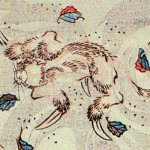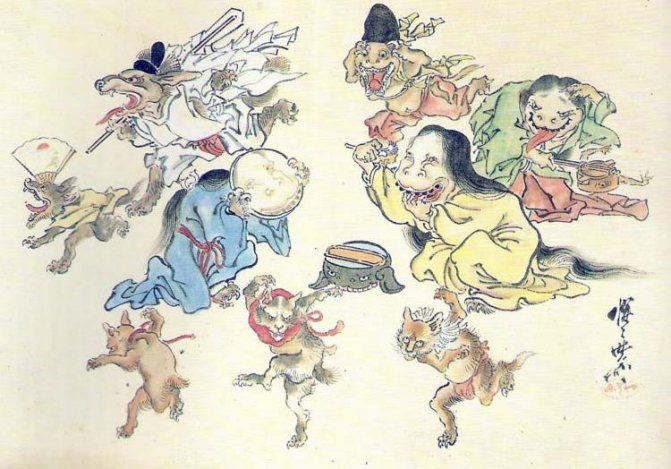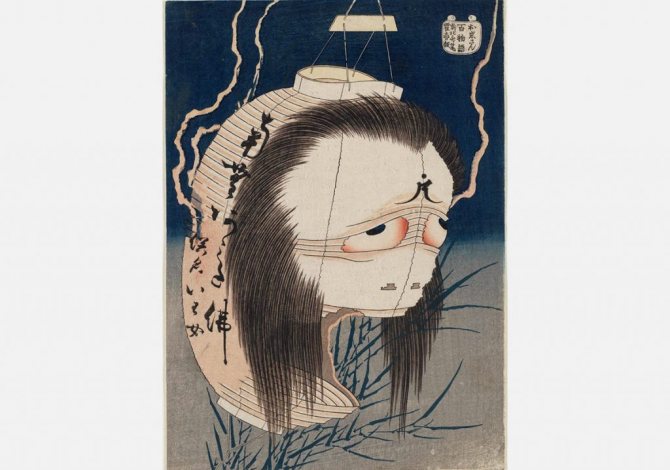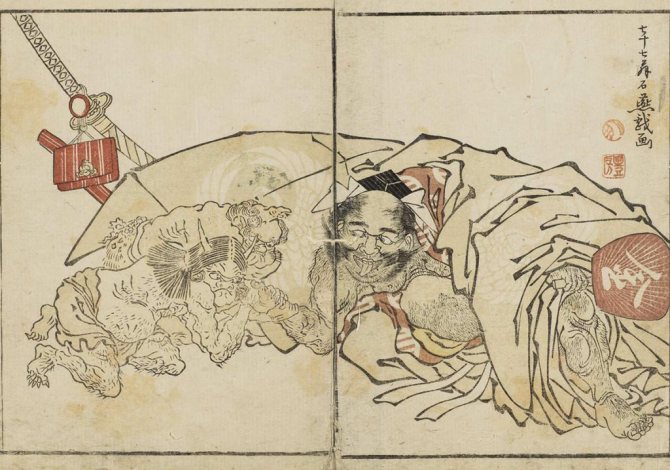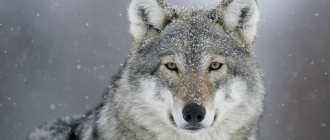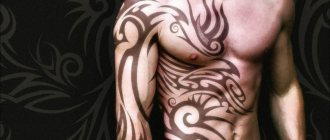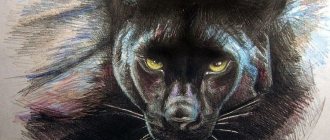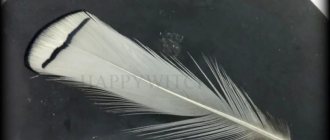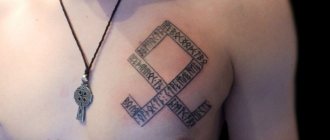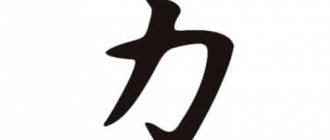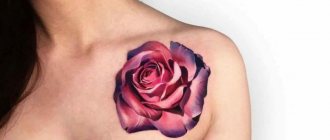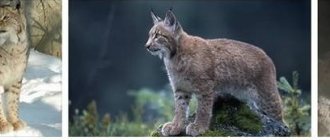.
In Japanese mythology, there are categories of monsters that share common skills and roles in folk tales. Demons Oni is a mythological class that includes fierce and powerful servants of Hell. Some of these creatures are servants of the gods, while others are characterized as evil spirits and spirits of nature. What all creatures have in common is a malevolent temper and uncontrollable rage.

General characteristics of the entities
In modern Japanese culture, the Oni class demons have a clear characteristic, but in ancient times this was the name given to all supernatural beings. In some legends Oni meant male monsters, while female demons had another name - Kijo. According to newer sources, these creatures are servants of the god Emma, the great judge of Hell.
The ferocious monsters deliver sinners to the Underworld and punish them severely. Legends indicate that people who do not control their anger and rage in life turn to Oni after death.
There is also a myth that a person who lives an extremely vicious life can turn into a monster while alive. Such Oni is a great danger to people, as he is not controlled by the gods.
Appearance
Externally, Oni monsters look like huge men whose skin color is different from normal. They have horns and protruding fangs. The creatures are dressed in a single loincloth made from the skin of a predator.
The creatures are armed with an iron club with spikes. The Japanese yakuza mafia often uses bats with nails hammered into the wood, imitating the weapons of the demons.
In some legends, the servants of Hell appear in a more feminine guise. They wear long hair, paint their lips and liner their eyes. They are also depicted with thin pipes, fans, and women's umbrellas.
This indicates a blurring of the line between feminine and masculine in the body of the demon. According to myths, this leads creatures to higher wisdom.
Magical Abilities
The magical arsenal They depend on the particular creature. However, some skills are common to the entire species.
- Changing Appearance. All creatures are werewolves and can take the form of both beasts and humans.
- Great strength and endurance.
- Ability to manipulate human feelings and emotions.
Character and attitudes towards humans.
Monsters They represent anger and rage. They are often portrayed as indestructible warriors whose emotions trump reason.
Despite this, monsters also possess good intellect, but in the heat of battle creatures forget about it, relying only on force. The attitude towards man depends on the type of demon. Some creatures are a threat to humans, others serve the gods and bring justice to the earthly world.
In many legends these creatures are cannibals. Only the gods restrain them from the total extermination of humanity.
Kama-itati
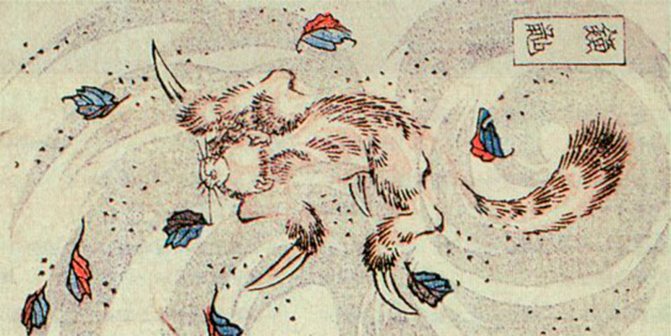

Kama-itachi. Illustration from Kyoka Hyaku monogatari, 1853. Image: Wikimedia Commons Kama-itachi is a Japanese yōkai (i.e., evil spirit) in the form of a weasel. Literal translation by M. D. Foster. The Book of Yokai: Mysterious Creatures of Japanese Folklore is "weasel with sickles." Tales of kama-itachi are popular in the Koshinetsu region of Japan.
These creatures always appear in threes - it is believed that they are triplets. What they do is cut off people's lower limbs. The sequence of actions is as follows: the first weasel knocks down the victim, the second one removes the legs with sickles that grow instead of claws, and the third one stops the blood and sews up the wounds.
But the most amazing thing is that the trio of kama-itachi, transported as a dust whirlwind, move at about the same speed as the Flash in the DC universe.
And it takes them less than a second to do the black thing.
Kama-itachi manages to pull off an amputation so that the victim feels no pain at all. It's nice that the caring weasels take the time to patch up the victim before flying off and taking his legs with them.
Moral: don't leave the house in a dust storm.
Types of demons They are.
It is impossible to determine exactly which of the Japanese monsters fits the description "demon Oni". To date, there are several classifications.
Noh Theater Masks.
Japanese traditional theater uses Oni demon masks during plays. They are also worn during festivals. The monsters of the Noh Theater can be divided into two categories: daikijin (godlike demons) and ordinary spirits.
Bonten
The female demoness Bonten belongs to the daikijin. This goddess came to Japan from Indian mythology and corresponds to Saraswati. Bonten has these characteristics:
- Bipersonality - before good people the goddess appears in the form of a beautiful girl, the evil ones she is, as an eight-armed woman, entwined with a snake.
- In a peaceful guise, Benten is accompanied by a lute, as this deity is the patron of music.
- Benten is the only possessor of the female gender among the 7 Gods of Happiness.
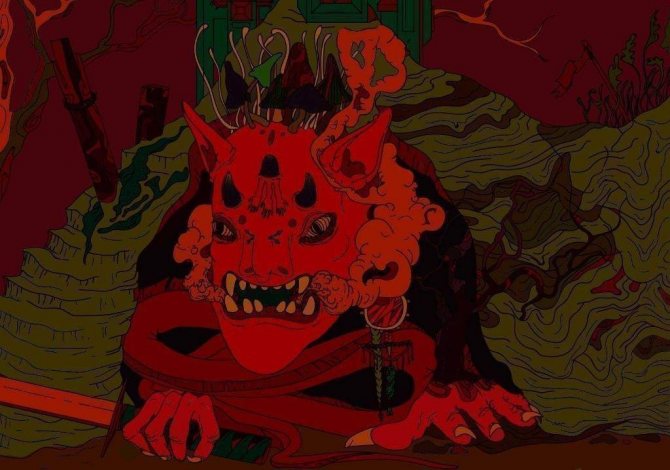

The Oni goddess takes on the guise of Oni when she punishes sinners. The mask for the evil guise is called Hannya. It looks like the white face of a woman with lined eyes and sharp horns. The image of this mask is often used for tattoos by yakuzo members.
Ryuuou
Literally, the name translates as "Lord of Dragons." Ryuuouou has the following characteristics:
- The creature looks like a Nag - the head and torso of the creature belong to man, and in place of the legs is a snake tail.
- According to legends, this monster lives in water or underground.
- The lord of dragons symbolizes the forces of nature, the wisdom of the earthly flow of time.
The mask of this creature is traditionally decorated with horse hair and yellow horns. The color of the creature is gold. Fangs protrude from the mouth of the monster. Such masks are classified as Shinjas (Dancing Snake).
Yasha
God-like demon, patron of the forest, mountain gorges and springs. Characteristics of Yasha:
- Duality - to good people the creature appears in the guise of a handsome young man and helps with advice. To evil people, Yasha appears as a terrible demon.
- Cannibalism and vampirism - in an evil guise, the monster eats impious victims.
- Serving the Gods. Yasha often carries out the will of the Japanese pantheon, punishing sinners and encouraging the righteous.
The name is derived from the Indian god Yaksha. The creature's Shinja mask is decorated with black horns and protruding long upper fangs.
In later variations, the appearance of the monster came close to that of a dog - a flat nose and a wide mouth with short fangs. The color of the mask is blue.
Kendatsuba
In India, some daikijinis are called Gandharvas. All creatures of this class are male and serve the chief deities. During their service they often act as antagonists, tempting people with vices. An encounter with these monsters Oni is a test of faith.
Outwardly their appearance is variable, but more often the creatures appear in the guise of half beasts. The lord of the gandharva Kendatsuba has such features:
- Externally, the creature looks like a man naked at the waist. The color of his skin is red.
- In his right hand is often a lute or a dharma wheel.
- Kendatsuba is considered the protector of children in Japanese mythology.
Gandharvas are also called "musicians of heaven. According to legends, these creatures are spirits of the wind and forest.
Asura
The demons of Ashur traditionally represent anger, pain and madness. In their pride, these spirits wished to overthrow the gods, for which they were exiled to Hell.
Despite their eternal fury, the Ashuras also patronize strategic wisdom and military might. Their lord Asura-no possesses such traits:
- Three faces. One face of the demon represents pain, the second - pride, and the third - anger.
- Six-armedness. In the two upper two hands the creature holds pearls of wisdom, in the pair of lower hands - arrows and flaming whip, and the middle palms are folded in a prayer gesture.
- Asura's skin color is red.


Mahoraka
These demons are related to serpent-werewolves. Nagas patronize science, research wisdom, and medicine. The leader of the Mahoraka, the Mahoraka possesses these characteristics:
- The color of the monster's skin is yellow.
- In the hands of the demon is often depicted a bivu, a stringed instrument.
- The creature itself looks like a waist-naked man.
Karura
In Buddhism, this Oni is the riding animal of the god Vishnu. According to legends, Karura is the enemy of the Asuras and Magoraks and the protector of all the righteous.
This creature points the way of faith, where one must cast aside doubt and science. All unbelievers and skeptics the creature sizzles with terrible flames.
Outwardly, the monster looks like Garuda, a half-man, half-bird. The demon is often depicted wearing expensive outfits and playing a flute.
Kinnara
These creatures look like birds and predators with human faces. Kinnara demons are the inferior servants of the Gods of Japan. The leader of these creatures, Kinnara, has these characteristics:
- The color of the Oni demon's skin is green.
- Kimnara clothes are embroidered with gold and silver.
- In his hands the creature holds a drum, which he beats loudly, warning people of his approach.
Momiji-Oni
This creature's name literally translates to "Demon of the Maple Leaves. According to Japanese mythology, Momiji is the patron of forests and the changing seasons.
In legends, this creature dyes sakura petals and maple leaves scarlet with the blood of humans. Momiji is also believed to be an ogre and cruel executioner.
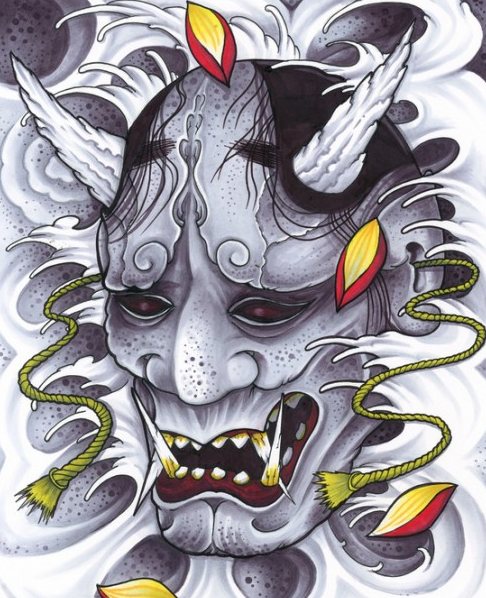

The mask of this Oni demon is red in color. It is decorated with horse hair and gold fangs protruding strongly from its mouth.
Ondeko-man
In Japanese, the creature's name translates as "demon who beats a drum." The creature's musical instruments and festive garb depict three commas, which symbolize the earth, sky, and humanity. Ondeko patronizes the harmony of man with nature, the balance of Yin and Yang in the world.
According to legends, this Oni demon passes through the world by dancing and tapping drums. Such a ritual promotes a good harvest and an increase in wealth.
The creature's mask is traditionally black, with red stripes. It is also decorated with white horsehair.
Kido-man
A demon who patronizes anger. Outwardly, it looks like a middle-aged bearded man. His mask has no obvious demonic features - the creature's face lacks horns and fangs.
Rekuki-Man
An Oni demon who preserves dishes. The exterior possesses a green skin tone and protruding fangs. A characteristic feature of the mask is a compressed mouth.
There is a Japanese tradition of eating from a plate shaped like the face of the Rekuki-men. The outside of the dish looks like an ugly demon, but the inside is light, with a smiling face on the bottom.
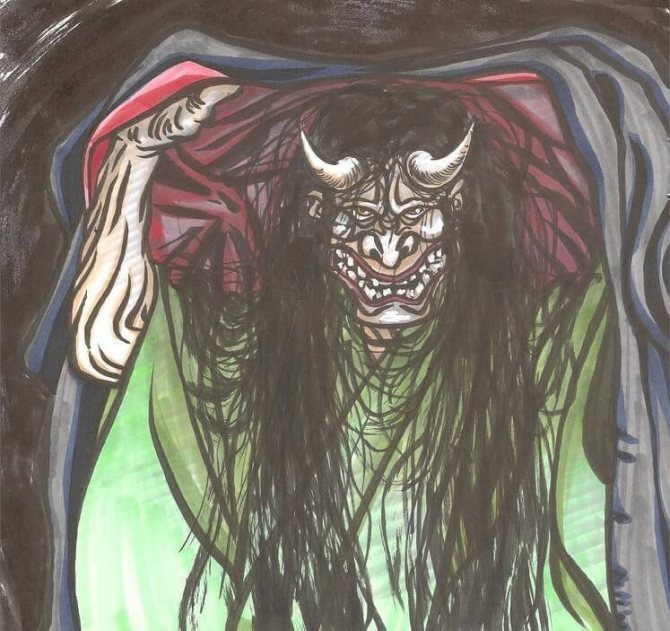

Some Japanese eat from such plates all year long, and on February 3, the holiday of purifying the country from demons, they smash the plates. This ritual is believed to bring happiness and wealth to the home.
Suten-doji
A demon whose parents are believed to be the Lord of the Wind, Susanoo, and the peasant's daughter Kushinadu, whom he saved. The god of wind built his son an estate near the entrance to the land of the dead.
Suten-dōji patronizes alcoholic beverages, particularly sake. Some legends claim that this Oni demon is a descendant of Yamat Orochi, from whom Susanoo saved Kushinada.
Suten-dōji has a beautiful appearance that can attract any girl. For this reason, Japanese women try not to talk to strangers, for fear of falling under the influence of the demon. The hair of this creature is bright scarlet and its skin is bronze in color.
Ao-Oni and Aka-Oni.
This pair of demons are twins. The only difference between them is their color - Ao is traditionally portrayed as blue, while Aka has a red skin tone.
The Oni brothers are not evil - in Japanese mythology, these creatures are often depicted as jesters and bullies. They are often portrayed as weak-willed and infantile.
In some myths, Ao and Aka try to make friends with children, but are chased away by humans because of their ugly appearance. The demons retaliate by hiding their clothes and killing pets.
Kuro-Oni
A creature with black skin and small horns. Kuro-Oni carries a small hammer, which, according to legends, beats the stupidity out of human heads.
In other sources, the demon is listed as the Master of Battles. He is depicted in samurai attire. Of the weapons present sword and a long harness. This rope demon drags sinners to Hell.
After a successful battle, Kuro-Oni dances the Dance of Death. Sometimes he is joined by Shaky-Oni, a blood demon.
Demons Oni in Japanese folk beliefs
Some monsters and spirits also have the prefix "-Oni" in their names. Their image is not used in Japanese theater, but there are many legends involving these creatures.
Usi-Oni
These creatures live on the shores of the ocean and seas. Outwardly, the demons resemble spiders with a bull's head.
They prey on humans by eating their meat. Most live along the coast and attacked the lone traveler, but in some legends, these demons devastated entire settlements.
Often hunted in tandem with the coast witch Iso-onna and the snake woman Nure-onna. The creatures are capable of poisoning water with their poisonous breath.
Amanojaku
A small-sized demon analogous to the European demon or Slavic devil. This folkloric character often plays the role of antagonist in Japanese fairy tales.
Amanojaku kidnaps girls, forcing their suitors to overcome many difficulties during the search. This creature also tests people's morals by offering gold in exchange for vicious behavior.
To defeat Amanojaka, all you have to do is be clever. When the demon's deception is revealed, the creature flees in fear from humans.
Oni Hitokuchi
A Japanese demon with a huge mouth. Its head is disproportionately large and, according to legends, it is capable of swallowing people whole.
In Japanese culture, the mouth of this creature is identified with the gates of Hell. Oni Hitokuchi is rarely mentioned in sources. Its arrival is a severe punishment of the gods.


Sazae oni
A snail demon that takes the form of beautiful women and lures sailors into traps. This creature feeds on human blood, desiccating its victims into a hollow shell.
According to legends, these monsters become promiscuous girls drowned at sea. The creatures mainly prey on men.
Nogitsune Oni
This demon is a subspecies of the kitsune, a werewolf fox. According to legend, such a creature becomes a spirit possessed by revenge.
Nogitsune rarely causes serious harm to people who have not offended her. In mythology, this creature plays the role of a trickster, a jester. However, a werewolf can cause serious damage to offenders, to the point of killing an entire family or even a village.
Konaki-diji
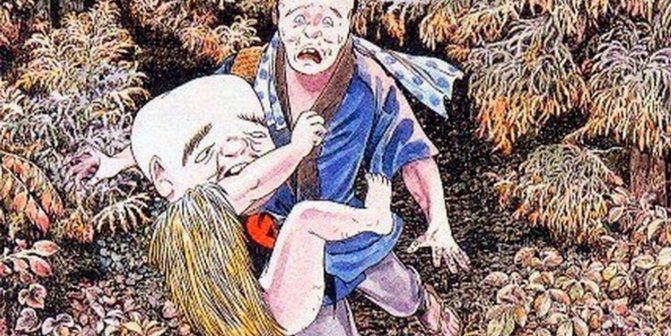

Konaki-diji. Illustration from the folklorist Kunio Yanagita's book Yōkai Dangi, 1956. Image: Public Domain
Konaki-diji is a supernatural being T. Francis-Cheung. The Element Encyclopedia of the Psychic World: The Ultimate A-Z of Spirits, Mysteries and the Paranormal , who looks like a small child or an infant altogether, but with the face of an old man. However, he is always prudently positioned so that his face can only be seen when it is too late to do anything about it.
Konaki-diji sits on the side of some mountain trail in a deserted area and roars.
The occasional traveler or traveler, seeing an abandoned child, picks it up in his arms to comfort it. As soon as the konaki-diji is lifted off the ground, it dramatically acquires additional mass (plus 2-3 centner) and flattens a good-hearted traveler.
Women in particular suffer from this yokai. First, they can't get past the sobbing baby. Secondly, the average Japanese woman has little chance of surviving after a konaki-diji falls on her. A particularly strong samurai, on the other hand, has a chance of surviving, in which case the yokai will reward him for his endurance.
Moral: Stay away from small children.
Mentions in Japanese legends
Oni monsters are popular characters in Japanese myths. The creatures often act as antagonists, but in theatrical productions they represent ultimate justice by dragging sinners to Hell.
The Legend of Issun Bossi
Issun Bossi is a mythological Japanese hero of tiny proportions. Legend has it that the married couple had no children, so the gods sent a child helper of small stature.
When Issun was 15 years old, he decided to try his luck in the world. The little man sat down in a rice pail and sailed eastward from his home. When he reached the big city of Kyota, the boy took a job as a servant in the house of a rich official.
The landlord was pleased with the little servant's diligent work. One day, the official's daughter was attacked by two fanged Oni demons, wanting to eat the girl. One of the monsters managed to swallow the tiny servant, but Issun was not frightened and began stabbing the demon's stomach walls with a needle point. Unable to endure the pain, the creature spat out the hero.


Issun began stabbing the demons' eyes and they fled in fear, forgetting their weapons at the scene of the battle. The boy struck the ground with his magic wand and it turned him into a beautiful man. According to legend, Issun and the official's daughter were soon married.
Legend of Jhankun.
The warlord Jaikun (Soki) occupies a significant place in Japanese mythology. His name literally translates as "peach stick.
According to legend, Jaikun served as a bodyguard for the Chinese ruler Huang Song. He was unable to protect his emperor from attack, so he slit his own throat with his own sword.
After his death, the man was reborn as a demon, but retained his noble spirit. After gaining magical powers, the former bodyguard decided to act against the rest of the monsters.
In Japan, this spirit protects people from Oni demons. Jaikun wears a Chinese kimono and fights with a Chinese short sword. According to some legends, the former warrior also keeps people safe from infectious diseases such as smallpox and malaria.
Myths about Namahage
These characters of Japanese folklore are associated with the celebration of the Eastern New Year. There are two legends that tell of the origins and abilities of these creatures.
The Myth of the Peasants
According to this story, Namahage was brought to Japan by the Chinese emperor Wu Han. The monsters They were part of his retinue. However, the creatures liked the mountain forests so much that Namahage decided to stay in the Land of the Rising Sun.
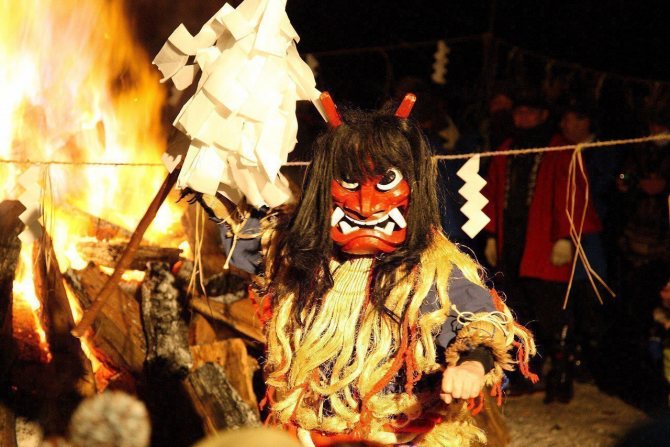

After some time, the demons fell in love with the villagers' daughters and began to demand that the local people give them the girls. However, the villagers decided to deceive the island guests. The villagers offered the monsters a deal - if they could knock out a ladder in the mountain before the first rooster crows, then the demons would be given the most beautiful girl of the village every year. If the monsters do not finish the construction on time, they will leave the village alone.
The creatures agreed to the deal. When the demons were laying the last stone, the villagers became frightened and imitated the cry of a rooster. The monsters became angry and left with nothing. As an apology for their deception, the villagers built a temple on the mountain, and every year they held a festival in honor of the Oni demons.
The Legend of the Sailors
According to the second legend, Nemahage came from the water, and if you please them with food and drink, the demons will bring happiness to the house. This myth arose because of the large number of shipwrecks off the coast of Japan. People were mistaken for demons after a catastrophe for such reasons:
- More often the victims of the shipwreck were Russian sailors, who were much larger than Japanese men.
- The foreign language was harsh to the Japanese ear and was associated with demonic language.
- The victims looked unkempt, making them resemble overgrown monsters.
The very name "Nama-hage" comes from the word for "cleanse" or "burn." According to legend, these demons come on New Year's Eve to cut the skin off people's heels. The word "namane" refers to the condition of the skin after being near a fire for a long time. So they call in Japan idlers, whose main occupation for a year was sitting at the stove. They are the ones who will be punished by the Oni demons.
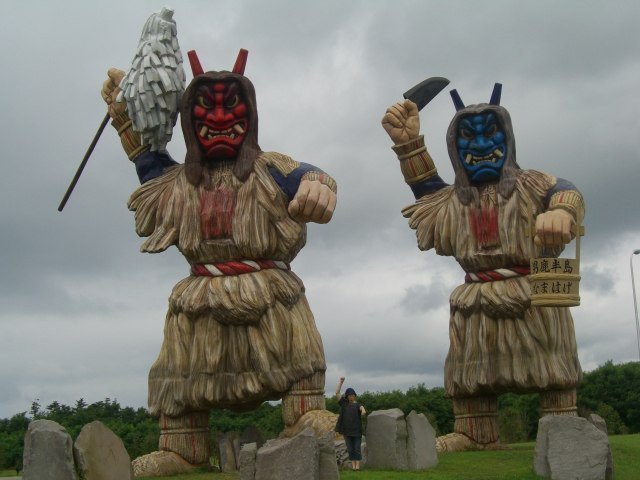

However, hospitable and hardworking hosts should not be afraid of monsters - after a hearty meal Namahage bring happiness to the house and guarantee the tenants a successful year. If you get the creatures drunk on alcohol, they will pick up some good advice.
It is believed that young people who want to marry, must treat these demons, so they asked the parents of the couple's permission to marry. The newlyweds themselves had no right to marry, but the mythical monsters were listened to by the older generation.
Demons also took care of the health of the hospitable hosts. In the homes visited by Namahage, children grew up strong and sturdy.
Who can and should not get a tattoo depicting Japanese demons
Unlike in the Land of the Rising Sun, there are no restrictions on such frightening images in Western culture. They are applied with symbolic and aesthetic purposes. They are suitable for people who want to surprise and shock others with spectacular images.
It is believed that such a tattoo carries a special energy and performs a protective function. Therefore, it is necessary to go responsibly to the choice of a suitable image. Given the length and complexity of applying such a tattoo, not everyone is able to endure the process to the end.
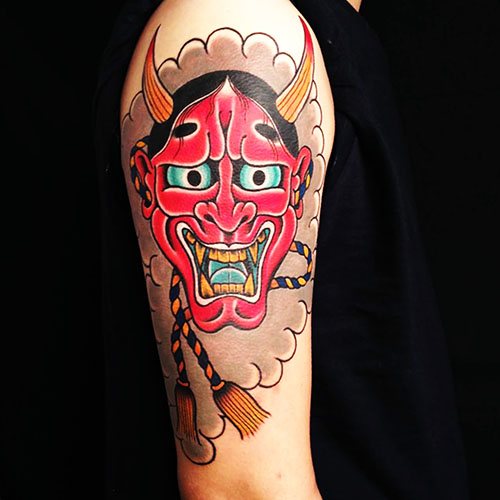

Japanese demon masks are highly artistic drawings with mystical meaning. Such tattoos have a number of absolute medical contraindications and temporary clinical limitations.
The first category includes:
- Chronic hematological diseases. Thrombocytopenia, afibrinogenemia and hemophilia significantly worsen blood clotting.
- Severe viral infections. These include hepatitis and HIV.
- Cancer tumors of any localization. Malignant tumor processes make the procedure of body painting impossible.
- Chronic inflammatory processes. Tattoos do not do with tuberculosis and other diseases that are associated with constant inflammation in the body.
- Depressed immunity. Such a condition increases the risk of infection by pathogenic microflora and slows the healing process of injured tissues.
- Mental disorders.
- Epilepsy.
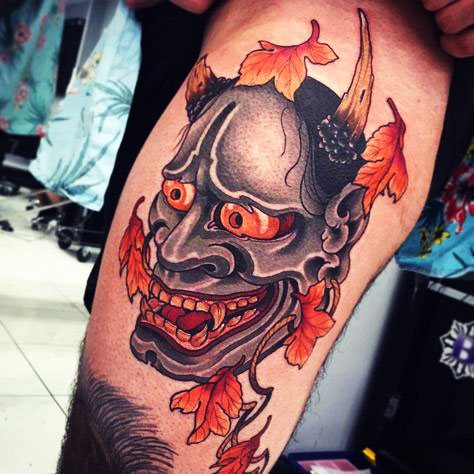

Tattoos should not be done by patients with endocrine pathologies, insulin-dependent diabetes and in the period of exacerbation of any chronic diseases. Absolute medical bans include susceptibility to sharp drops of blood pressure.
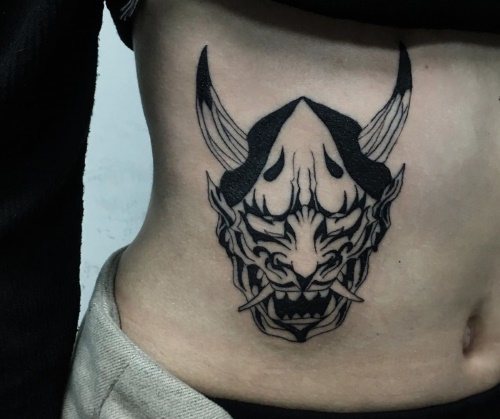

Temporary clinical restrictions on the procedure include:
- active inflammation of the skin in the manipulation area;
- Disruption of the integrity of the epidermis - wounds, scratches, cracks, burns, etc;
- Exacerbation of dermatological diseases of a chronic nature;
- tendency to allergic reactions;
- colds;
- Increased body temperature.
Tattoos are not performed during the period of pregnancy, breastfeeding, menstrual cycle. Masters are not allowed to accept clients under the influence of alcohol or drugs.
Setsubun Festival
It is a traditional holiday in Japan associated with the change of seasons. The festival is held on February 3. An important ritual is the ritual called "Mame-maki" - the exorcism of Oni demons. The ritual includes the following actions:
- The eldest member of the family puts on a mask of an Oni demon and begins to scare the rest of the relatives. Sometimes famous personalities or sumo wrestlers are invited to play the role of the monster.
- The children and spouse pelt the man with refried beans.
- After removing the mask, the head of the family also scatters the beans around the house.
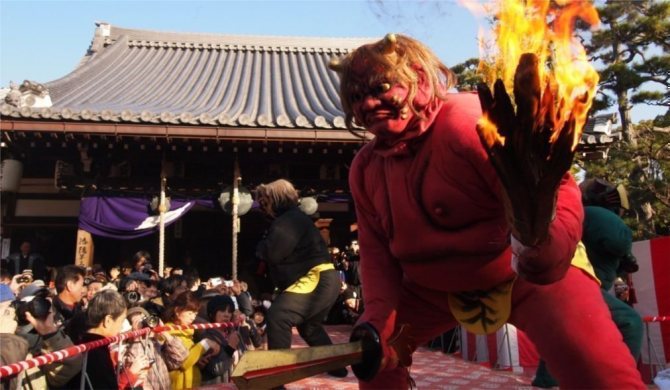

According to legend, demons can't stand the smell of soybeans, and run back to Hell in fear. Also on this day there are mass processions in masked Noh theater. The steps of the temples are sprinkled with roasted soybeans and beans, and each person must eat as many bean grains as he is old.
Yurei
They are the ghosts of the dead, unable to reach peace, stuck and suffering between the two worlds. The two kanji 幽霊 (yūrei) mean "weak" or "dull" and "soul" or "spirit," respectively. Typical yūrei have long tangled (and frightening) black hair, white clothing, lifeless arms hanging down, sometimes no legs, and ghostly lights can also be seen nearby.
According to traditional beliefs, when a person dies, his reikon (soul) is sent to purgatory, where it awaits a proper funeral and rites to be performed before it can go to its final resting place to its ancestors. Yurei is a raikon who has not completed this journey. Murder, suicide, revenge, hatred, or grief are among the many strong feelings that can become a chain for such a soul to bind it to this world. In order for the yurei to move on, a proper funeral rite must be performed or the problem that is keeping him from leaving must be resolved.
Japanese folklore and ghost stories are as important as its long history. Just by reading about the legends, it's hard to understand the full meaning behind them, but a trip to this country is a good way to see just how complex these beliefs are.
If you want to learn more about Japanese folklore and culture, keep reading our blog, join our Facebook and VKontakte groups, and subscribe to our Instagram account.


Get the Official Go! Go! Nihon Merchandise
Buy now
Nurarihyon
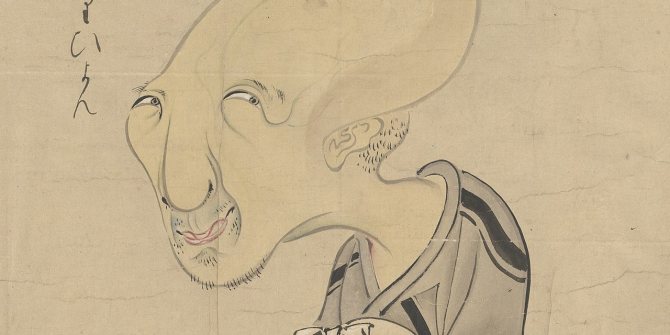

Nurarihyon. Illustration from Harry F. Bruning's collection of Japanese books and manuscripts. Image: Wikimedia Commons
Nurarihyon is an ayakashi M. D. Foster. The Book of Yokai: Mysterious Creatures of Japanese Folklore , a supreme yokai demon. His standard appearance is that of an extremely ugly monk with an enormous head. However, the nurarichön has a superpower: when it enters someone's house, it begins to look and behave just like the owner of the house.
Once inside, while the owners are away, the nurarichön begins to use the house as if it were his own. For example, he drinks tea, takes the things he likes, and perhaps even subscribes to paid streaming services at your expense. He nonchalantly tells his neighbors that he just didn't make the trip, that's why he's home.
Just imagine: any friend you visit may not be someone you know well, but a gloomy supreme yokai.
Maybe it's because of Nurarihon's shenanigans that the Japanese are so polite and obsessed with formality and propriety. Or maybe it's because of the samurai, who liked to cut off heads for every oblique look. And that's a very good way to cultivate politeness in the survivors.
Moral: Be extremely careful, even with people you've known for a long time. Just in case.
Ittan Man
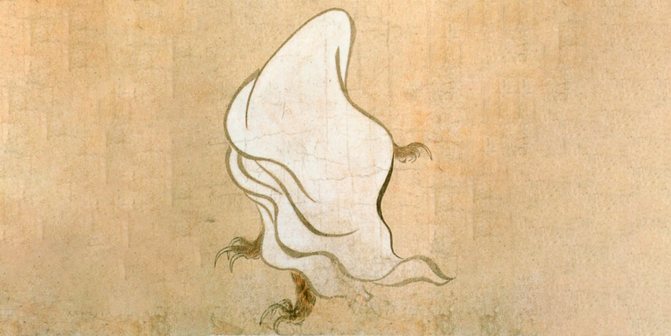

Ittan-moman. Drawing by Tosa Mitsunobi, 16th century. Image: Wikimedia Commons
The Japanese have a belief that if a forgotten object is left lying around long enough (such as 100 years), it will become conscious and turn into a yokaya, tsukumogami. An ittan-moman is a sheet that has become sentient.
This wild but cute ghost without a motor loves to swoop down on passersby at night and strangle them.
There is a legend L. Bush. Asian Horror Encyclopedia: Asian Horror Culture in Literature, Manga and Folklore , that this cursed levitating sheet once nearly killed a samurai. But he managed to take out his wakizashi blade and cut the ghost. Ittan-moman disappeared, leaving bloody footprints on the warrior's hands.
Other lore has it that the yttan man can befriend and even serve the man if he succeeds in earning the ghost's trust. No one really knows what a flying piece of cloth can do for you, though.
That's because no one has been able to make friends with him yet, and in fairy tales, this point is tactfully avoided. So if you find yourself in Japan and encounter an ittan-moman, you'll have to test this theory yourself.
Moral: don't hoard old things, or they'll try to kill you.
Kasa obake
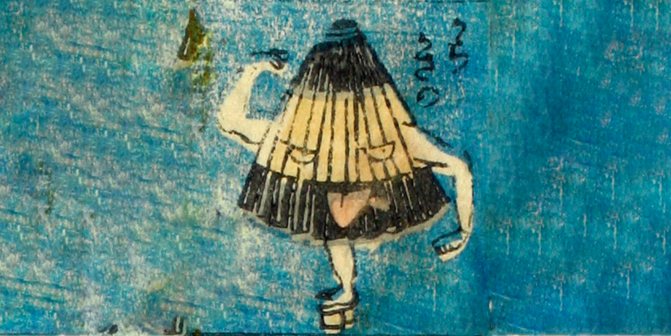

Kasa obake. Illustration from the collection of the International Research Center for Japanese Studies. Image: Public Domain
Another type of tsukumogami. An umbrella that has been lying around for 100 years unattended turns into a kasa obake. It grows one leg, two arms, an eye, and a long tongue and goes M. D. Foster. The Book of Yokai: Mysterious Creatures of Japanese Folklore on his own business.
Doesn't sound very dangerous, does it? Wrong, in Japan even an umbrella will try to kill you.
If you see an umbrella standing alone in the dark on a rainy night in Higashiuwa, Ehime Prefecture, run away. Because if it looks at you with its only eye, you will be paralyzed.
In addition, sometimes the demonic umbrella grabs people with its claws on its only leg and, driven by a strong wind, rises into the sky and flies off with its victim to an unknown destination.
Moral: It's time to run out of the way to dismantle the contents of the closet.
Tsuchigumo
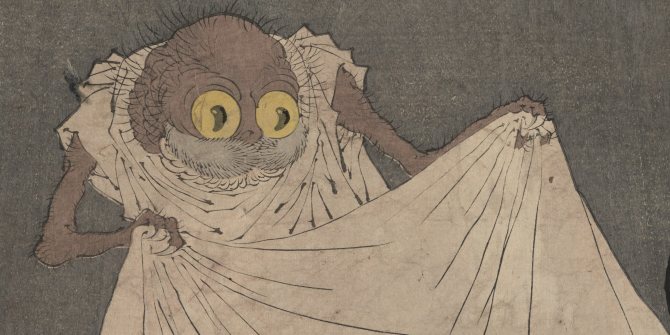

Tsuchigumo. Illustration by Yoshitoshi Taizo, 1839-1892. Image: Wikimedia Commons
The word tsuchigumo ("earth spider") was once the name given to the indigenous tribes of the Japanese islands who stubbornly refused to submit to the sun-like Nihon Emperor. But in time the barbarians were conquered, but the demonic image remained in folklore.
Tsuchigumo is a horrible yokai with the body of a tiger, the limbs of a spider, and a terrifying face, compared to which any European demon looks quite cute and even cuddly. These monsters inhabit G. Kenkyūsha. Nihon no yōkai no nazo to fushigi in the vicinity of Mount Yamato Katsuragi. They feed on careless travelers. Although, strictly speaking, they occasionally consume the cautious ones as well.
A samurai once dragged himself up Mount Yamato, apparently to visit a temple there and meditate while admiring the mountain sakura. On his way he encountered a tsuchigumo spider. The monster tried to braid a web around the warrior, but he silently drew his katana and cut the arthropod into two halves. From a belly tsuchigumo fell out exactly 1 990 skulls - the samurai was not too lazy to count.
You see, these Japanese legends are true. Otherwise, would storytellers have given such exact numbers?
As the slain yokai fell to the ground, thousands of little spiders scattered from its sides in all directions. The samurai followed them into their lair with his katana at the ready-though any sane person would only venture into such a place with an OZK suit and a flamethrower. In the spider's burrow the warrior found twenty more skulls.
Moral: spiders are disgusting and dangerous.
Gasadokuro


Gasadokuro. Illustration by Utagawa Kuniyoshi, 1844. Image: Wikimedia Commons
If the dead are not removed from the battlefield or buried in mass graves, their bones will eventually gather in gasadokuros M. D. Foster. The Book of Yokai: Mysterious Creatures of Japanese Folklore . It is a huge skeleton composed of normal-sized skeletons. It is known that the gasadokuro is exactly 15 times larger than a normal person and is 27 meters tall.
Don't ask how the Japanese got the exact numbers, just take it as a given.
The earliest tales of the gasadokuro go back to K. Friday. The First Samurai: The Life and Legend of the Warrior Rebel, Taira Masakado to the 10th century. Since the monster emerged from the remains of those who died of war, epidemics or famine, its character, as you understand, is not very pleasant. The skeleton is not evil in and of itself; it just has a hard life.
But in general, the skeleton may not be evil per se - it's just that his life is hard. Sometimes he even shows friendliness to those who have done him a favor. There is a tale from the book Nihon Ryōiki, written between 787 and 824. One day a certain Japanese man was walking at night (bad idea, very bad idea) through a field in Bingo Province in Hiroshima Prefecture and heard a monstrous howl, "My eye! My eye hurts!"
A reasonable person would have immediately scrambled away, but not this samurai. He found a giant skeleton with a bamboo shoot sticking out of its eye socket, took out the stem, and treated the ghasadokuro to boiled rice. Impressed by his kindness, he told the hero the story of how he died and rewarded the warrior generously. Then he scattered, finding peace.
Moral: Be kind and help those around you. Or run away at once, or you will be eaten.
Sirimae
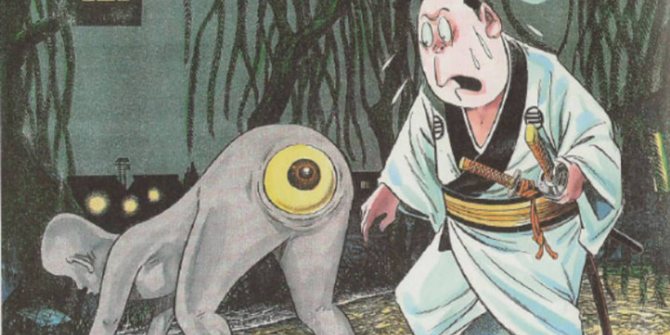

Sirime. Image: Njadaka1 / Wikimedia Common
Time for a specific Z. Davisson. Yurei: The Japanese Ghost of Japanese humor. Once upon a time, a certain samurai was walking at night on the road to Kyoto. The samurai is not supposed to walk around at night in the middle of nowhere, as you can imagine, and in Japan especially, it's a very bad idea. But a warrior shouldn't trouble his mind with such trivialities. A samurai has no goal, only a path.
Suddenly he heard a plea behind him to turn around. The warrior did so and saw a strange man in a kimono. This exhibitionist immediately turned his back to the samurai, threw off his clothes and bent down.
And then the warrior saw a huge sparkling eye.
Offended by such an indecent gesture, he immediately drew his katana and cut the insolent man down on the spot... no. In fact, the unworthy coward, unable to follow the Bushi Code, simply ran away.
Shirime literally translates to "eye and buttocks." Why is this yokai acting like this? Probably just because he can afford it.
Moral: Don't mess with tramps. And don't turn around.
Katakirauwa


"The Emperor and the Boar," by Ginko Adachi, 1896. Image: Wikimedia Commons
Have you noticed that all Japanese ghosts are rather unusual characters? Well, the katakirauwa look rather modest against their backdrop. These are the ghosts of black piglets M. D. Foster. The Book of Yokai: Mysterious Creatures of Japanese Folklore , which have one ear and cast no shadows, but otherwise look pretty decent. However, there is one problem with them.
If the spirits manage to run between your legs, they'll eat your soul and one of the piglets will possess your body.
I'd rather have a 27-foot skeleton, wouldn't you? At least you can see it from a distance.
Moral: watch your step.
Oshiroi Baba
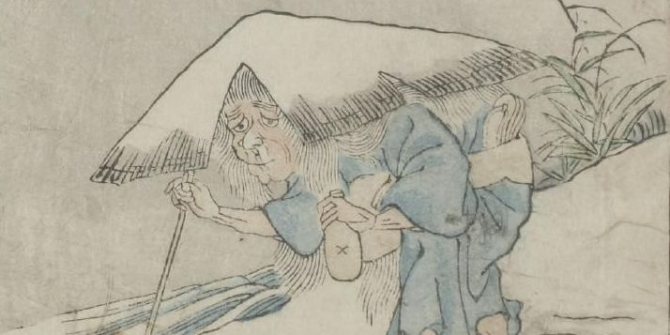

Oshiroi Baba. Illustration from Konjaku Hyakki Shūi, 1780. Image: Wikimedia Commons
Ghost T. Francis-Cheung. The Element Encyclopedia of the Psychic World: The Ultimate A-z of Spirits, Mysteries and the Paranormal in the form of a horrible, disgusting hunchbacked old woman. Her face is crudely powdered and she holds a bottle of sake in her hand. Oshiroi Baba walks the streets with an umbrella and a stick and looks out for beautiful young women.
When she finds one, she immediately runs up to her and, in a heartfelt voice, begins to persuade her to buy some powder from her.
The naive girl agrees to take a sample, dabs on the powder, and her face falls off.
Moral: if you are a young beautiful woman and a pushy cosmetics salesman approaches you - walk away silently.
